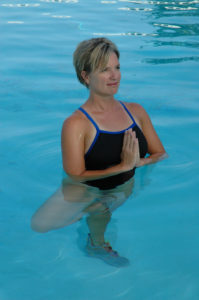What do water exercise and yoga have in common? When practiced with purpose, both joint-friendly programs keep the body balanced, strong and less prone to injury.
Bringing water and yoga together has an even bigger impact. It’s the best combination for everything. Restorative movement. Strength. Flexibility. And the benefits don’t stop there.
Internationally known water exercise and yoga teachers, Laurie Denomme and Lauren Eirk have teamed up to create an innovative program that explores familiar poses in new and challenging ways. Experience an aqua yoga program like no other. Fans of water exercise and yoga alike will be impressed with their improved fitness level and general sense of well-being after each workout.
Addictive in a good way, Aqua Yoga Strength is for everyone!
Understanding Yoga
Common to current yoga understanding is that stretching deeper into yoga poses will lengthen and improve muscle flexibility for greater range of motion and improved function. But is becoming more flexible really the right focus?
Don’t get me wrong. Flexibility is important, but it doesn’t work alone. Stability and strength are also important in a healthy, fit body. Here’s why. The muscular system is much like a newly planted tree held up by guide wires. When muscles are weak, their protective response is to tighten, acting as guide wires for our skeletal system. The strength of a muscle is measured by how much force it can withstand. Stability is having both strength and the ability to effectively control a motion.
So strength actually plays an important role in flexibility, and without strength, the body can’t be flexible. This is the reasoning behind our belief that yoga teachers should prioritize helping students strengthening muscles and learn the correct way to move in and out of poses. Improved stability provides the body with the sense of control it needs to let go of protective mechanisms, while a strength-focused yoga practice will deliver the flexibility our bodies crave!
Yoga Pose Deconstruction

This course will introduce you to hatha yoga (yoga grounded in a physical practice) through a new lens. Pose deconstruction will provide you with the know-how to effectively coach others to get more out of their yoga practice and provide modifications to accommodate everyone in your class. Here’s a sample of what you can expect to learn.
Give it a try! Tree Pose (Vrksasana):
- Start in mountain pose
- Lift heel of one foot
- Externally rotate the hip
- Flex the hip and knee
- Place foot on medial aspect of the standing leg (above or below the knee)
- Arms overhead with elbows straight (option prayer position)
If you’ve tried this pose on land or in the pool, you’ll see students with good balance grab hold of their lower leg and place it against the inner thigh of the standing leg. Perhaps this is how you got into the pose just now? Before I learned how to practice strength-focused yoga, I too was guilty! Leg comfortably nestled into my standing leg, relaxed and stable, I could do tree pose forever. Let’s try it again with a strength focus.
Repeat steps one through six. As you do step five do not use your hand to assist the leg. Well done! You’ve just discovered your active range of motion. Now as you stand in tree pose, engage the adductors of the standing leg (feel the hip moving toward the midline).
If you’re like me, a couple of big things just happened. First of all, I was no longer as good at tree pose. But using the hand to assist placement of the suspended foot, requires no muscle engagement to get there. Without engaging the adductors (inner thigh), the body is hanging on the joints, without need to recruit very many muscles to hold the position. Engaging the adductors and sliding the hip towards the midline actively engages the hip muscles. This is a simple concept with a huge impact.
Author: Laurie Denomme, Founder of WECOACH and Creator of Wavemakers®
